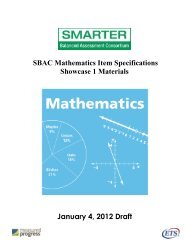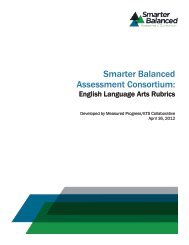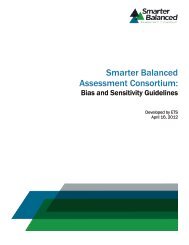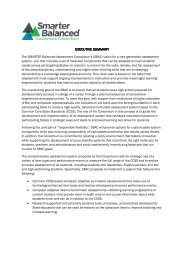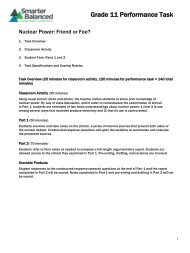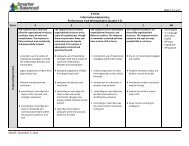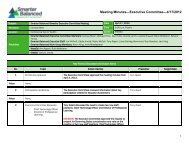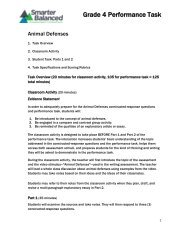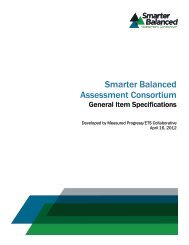Content Specifications for the Summative Assessment of the ...
Content Specifications for the Summative Assessment of the ...
Content Specifications for the Summative Assessment of the ...
You also want an ePaper? Increase the reach of your titles
YUMPU automatically turns print PDFs into web optimized ePapers that Google loves.
In <strong>the</strong> case <strong>of</strong> <strong>the</strong> Common Core, “societal expectations (values)” include preparing students <strong>for</strong> college<br />
and careers. <strong>Content</strong>-specific research and cognitive research help to identify <strong>for</strong> educators (both<br />
visually and verbally) hypo<strong>the</strong>ses about how students will typically move toward increased<br />
understanding and build expertise in reading, writing, speaking, and listening.<br />
The general mapping <strong>of</strong> how skills and concepts might be best learned over time, while being organized<br />
around unifying ideas, provides much more than a simple scope and sequence, pacing guide, or<br />
checklist <strong>of</strong> skills. Later skills can clearly be built upon earlier prerequisite learning. These kinds <strong>of</strong><br />
progressions are reflected in <strong>the</strong> assessment targets we describe below across grades. 4, 8, and 11.<br />
The <strong>Assessment</strong> Design<br />
The proposed SBAC summative assessment design proposes to sample all CCSS strands, with <strong>the</strong><br />
exception <strong>of</strong> Reading Foundational Skills, which we suggest should be evaluated in <strong>the</strong> early grades<br />
using any <strong>of</strong> a number <strong>of</strong> widely available diagnostic assessments <strong>for</strong> evaluating <strong>the</strong> developing reading<br />
and literacy skills <strong>of</strong> young children. (See table below.) The assessment targets attend both to depth <strong>of</strong><br />
content and skills and to a range <strong>of</strong> item types and breadth <strong>of</strong> content across strands.<br />
CCSS ELA &<br />
Literacy Strands<br />
Reading<br />
Standards:<br />
Foundational<br />
Skills K–5<br />
Reading Standards<br />
<strong>for</strong> Literature<br />
K-5, 6-12<br />
Reading Standards<br />
<strong>for</strong> In<strong>for</strong>mational<br />
Text<br />
K‐5, 6‐12<br />
Writing Standards<br />
K-5, 6-12<br />
Speaking and<br />
Listening<br />
Standards<br />
K‐5, 6‐12<br />
Reading Standards<br />
<strong>for</strong> Literacy in<br />
History/Social<br />
Studies 6–12<br />
How each CCSS strand and related standards are proposed to be addressed<br />
within <strong>the</strong> SBAC assessment system<br />
For results to be instructionally timely and useful, <strong>the</strong>se standards are best assessed<br />
locally by teachers: intensively at K-2 grades and <strong>the</strong>n systematically at grade<br />
levels above grade 2. Foundational reading skills can be assessed with <strong>the</strong> many<br />
existing valid and reliable diagnostic and <strong>for</strong>mative assessments, using <strong>the</strong> data to<br />
make ongoing instructional and remediation decisions.<br />
Assess both strands (RL and RI) and standards primarily under Claim #1 and<br />
generally apply <strong>the</strong> distribution <strong>of</strong> emphasis <strong>for</strong> text types recommended in <strong>the</strong> CC.<br />
Anchor Standard 1 in reading (and each grade specific version <strong>of</strong> this standard)<br />
governs Reading Standards 2-9. It focuses on students’ use <strong>of</strong> evidence to support<br />
<strong>the</strong>ir analyses (claims, conclusions, inferences) about texts. Hence, whe<strong>the</strong>r<br />
students are asked to determine <strong>the</strong> central idea, <strong>the</strong> point <strong>of</strong> view, or <strong>the</strong> meaning<br />
<strong>of</strong> words and phrases and <strong>the</strong> like, <strong>the</strong>y will be using Standard 1 (making inferences<br />
and supporting those inferences with evidence) in addition to one <strong>of</strong> <strong>the</strong> o<strong>the</strong>r<br />
reading standards 2-9. As a result, Standard 1 underlies each <strong>Assessment</strong> Target.<br />
Most or all <strong>of</strong> <strong>the</strong>se items can likely be included in a computer-adaptive test (CAT).<br />
Guidelines <strong>for</strong> text selection <strong>for</strong> summative assessments need to be developed in<br />
light <strong>of</strong> Reading Standard 10. Guidelines <strong>for</strong> texts used to assess reading may be<br />
different from those used to assess writing (claim #2) and research (claim #4)<br />
where students will be asked to analyze and draw evidence from given texts.<br />
Assess 3 key writing types and standards (W1 - W6 & W9) under Claim #2 and<br />
generally apply distribution <strong>of</strong> emphasis recommended in <strong>the</strong> CC. Apply writing<br />
standards W4-W9 as well to production <strong>of</strong> content-related texts and report under<br />
Claim #4 (Research). Full compositions, involving planning and revision, would<br />
best be assessed with per<strong>for</strong>mance tasks; while some editing and revision tasks may<br />
be accomplished in <strong>the</strong> CAT portion <strong>of</strong> <strong>the</strong> summative assessment.<br />
Assess selected speaking and listening skills under Claim #3. Some speaking and<br />
listening standards may only be appropriate <strong>for</strong> local <strong>for</strong>mative and interim<br />
assessment purposes.<br />
Conducting short research projects (Research to Build and Present Knowledge:<br />
standards W7-W9) is included in <strong>the</strong> CC at all grade levels K-12. Research<br />
standards to build knowledge <strong>of</strong> topics would likely be applied in local curriculums<br />
18



